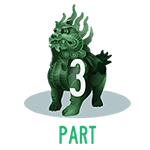The Rush For Jade in British Columbia
Infographic presented by Electra Stone Many years ago, jade used to travel to China along the Silk Road. Today, more and more jade is being shipped across the Pacific Ocean from British Columbia. China is the epicenter of jade demand and culture, and today’s infographic shows how jade is formed, the rush for BC jade, and how jade gets from the boulder to the market.
How Jade is Formed
Finding high-quality jade is extremely difficult, which is part of the reason it is so valuable. Jade is created in areas of the world that have subduction zones, such as around the Ring of Fire. Subduction occurs when two tectonic plates collide and one is forced under the other. The elements are carried deep into the earth, where immense heat and pressure creates the necessary conditions for the formation of jade. This process takes 60 million years. Most of the world’s jade forms in areas with this kind of intense geological activity. Xinjiang, home to China’s most important nephrite jade deposits, his near where the Indian plate is colliding with the Eurasian plate. In British Columbia, the conditions are similar, and jade can now be found throughout Canada’s westernmost province. Specifically, there are three areas where today jade is mined: Dease Lake, Mount Ogden, and Cassiar.
The Jade Market
The global market for jade is dominated by Myanmar (formerly Burma) where the majority of jadeite is produced. The size of the reported jade market is largely dependent on data from Myanmar. Before conflict and mine shutdowns resumed in the country in 2011, jade sales were estimated to be $3.5 billion per year. These shutdowns led to a supply gap in jade, and that is where British Columbia comes in: the production of BC jade has increased from 1.7% to 8.3% from 2011 to 2014. A 2013 Harvard report put out a more in-depth assessment of the global jade market, and estimated it to be $8 billion.
The BC Jade Market is Booming
Demand for the most desired jade, which comes in an emperor green colour, has put significant price pressure on BC jade. Production of BC jade has doubled, and prices for gem quality jade have jumped to $200-$1,000 per kg.
From Source to Market
BC jade can be found in hard rock deposits or in alluvial boulders that have been moved by glaciers over time. “New mine jade” refers to jade found in hard rock deposits. This is typically more weathered and more susceptible to cracking. “Old mine jade” is jade that has been dragged by glaciers in boulder form. Only the best boulders survive, and typically these are of high quality. Jade is similar to gold in that it can be found in a pure form in nuggets in streams and rivers. Often, the most ambitious Chinese buyers may fly in via helicopter to the northern jade sites to buy jade “off the bucket” in cash. This ensures the best quality jade and miners also benefit. The jade then typically makes its way to a hub like Vancouver to get shipped overseas to China. China is by far the world’s largest market for jade, where it is considered a hard asset and a symbol of wealth, purity, and spirituality. China is also home to the most brilliant jade craftspeople in the world. Finally, after sometimes years of intricate carving, the jade is sold in major retail centers like Hong Kong or Beijing. Once a finished product, the jade can sell for up to 10x its original price, creating wealth throughout the value chain. As an example: the Polar Pride Boulder was carved into a massive Buddha and sold for $1 million in 2004.
on Did you know that nearly one-fifth of all the gold ever mined is held by central banks? Besides investors and jewelry consumers, central banks are a major source of gold demand. In fact, in 2022, central banks snapped up gold at the fastest pace since 1967. However, the record gold purchases of 2022 are in stark contrast to the 1990s and early 2000s, when central banks were net sellers of gold. The above infographic uses data from the World Gold Council to show 30 years of central bank gold demand, highlighting how official attitudes toward gold have changed in the last 30 years.
Why Do Central Banks Buy Gold?
Gold plays an important role in the financial reserves of numerous nations. Here are three of the reasons why central banks hold gold:
Balancing foreign exchange reserves Central banks have long held gold as part of their reserves to manage risk from currency holdings and to promote stability during economic turmoil. Hedging against fiat currencies Gold offers a hedge against the eroding purchasing power of currencies (mainly the U.S. dollar) due to inflation. Diversifying portfolios Gold has an inverse correlation with the U.S. dollar. When the dollar falls in value, gold prices tend to rise, protecting central banks from volatility. The Switch from Selling to Buying In the 1990s and early 2000s, central banks were net sellers of gold. There were several reasons behind the selling, including good macroeconomic conditions and a downward trend in gold prices. Due to strong economic growth, gold’s safe-haven properties were less valuable, and low returns made it unattractive as an investment. Central bank attitudes toward gold started changing following the 1997 Asian financial crisis and then later, the 2007–08 financial crisis. Since 2010, central banks have been net buyers of gold on an annual basis. Here’s a look at the 10 largest official buyers of gold from the end of 1999 to end of 2021: Rank CountryAmount of Gold Bought (tonnes)% of All Buying #1🇷🇺 Russia 1,88828% #2🇨🇳 China 1,55223% #3🇹🇷 Türkiye 5418% #4🇮🇳 India 3956% #5🇰🇿 Kazakhstan 3455% #6🇺🇿 Uzbekistan 3115% #7🇸🇦 Saudi Arabia 1803% #8🇹🇭 Thailand 1682% #9🇵🇱 Poland1282% #10🇲🇽 Mexico 1152% Total5,62384% Source: IMF The top 10 official buyers of gold between end-1999 and end-2021 represent 84% of all the gold bought by central banks during this period. Russia and China—arguably the United States’ top geopolitical rivals—have been the largest gold buyers over the last two decades. Russia, in particular, accelerated its gold purchases after being hit by Western sanctions following its annexation of Crimea in 2014. Interestingly, the majority of nations on the above list are emerging economies. These countries have likely been stockpiling gold to hedge against financial and geopolitical risks affecting currencies, primarily the U.S. dollar. Meanwhile, European nations including Switzerland, France, Netherlands, and the UK were the largest sellers of gold between 1999 and 2021, under the Central Bank Gold Agreement (CBGA) framework. Which Central Banks Bought Gold in 2022? In 2022, central banks bought a record 1,136 tonnes of gold, worth around $70 billion. Country2022 Gold Purchases (tonnes)% of Total 🇹🇷 Türkiye14813% 🇨🇳 China 625% 🇪🇬 Egypt 474% 🇶🇦 Qatar333% 🇮🇶 Iraq 343% 🇮🇳 India 333% 🇦🇪 UAE 252% 🇰🇬 Kyrgyzstan 61% 🇹🇯 Tajikistan 40.4% 🇪🇨 Ecuador 30.3% 🌍 Unreported 74165% Total1,136100% Türkiye, experiencing 86% year-over-year inflation as of October 2022, was the largest buyer, adding 148 tonnes to its reserves. China continued its gold-buying spree with 62 tonnes added in the months of November and December, amid rising geopolitical tensions with the United States. Overall, emerging markets continued the trend that started in the 2000s, accounting for the bulk of gold purchases. Meanwhile, a significant two-thirds, or 741 tonnes of official gold purchases were unreported in 2022. According to analysts, unreported gold purchases are likely to have come from countries like China and Russia, who are looking to de-dollarize global trade to circumvent Western sanctions.
There were several reasons behind the selling, including good macroeconomic conditions and a downward trend in gold prices. Due to strong economic growth, gold’s safe-haven properties were less valuable, and low returns made it unattractive as an investment.
Central bank attitudes toward gold started changing following the 1997 Asian financial crisis and then later, the 2007–08 financial crisis. Since 2010, central banks have been net buyers of gold on an annual basis.
Here’s a look at the 10 largest official buyers of gold from the end of 1999 to end of 2021:
Source: IMF
The top 10 official buyers of gold between end-1999 and end-2021 represent 84% of all the gold bought by central banks during this period.
Russia and China—arguably the United States’ top geopolitical rivals—have been the largest gold buyers over the last two decades. Russia, in particular, accelerated its gold purchases after being hit by Western sanctions following its annexation of Crimea in 2014.
Interestingly, the majority of nations on the above list are emerging economies. These countries have likely been stockpiling gold to hedge against financial and geopolitical risks affecting currencies, primarily the U.S. dollar.
Meanwhile, European nations including Switzerland, France, Netherlands, and the UK were the largest sellers of gold between 1999 and 2021, under the Central Bank Gold Agreement (CBGA) framework.
Which Central Banks Bought Gold in 2022?
In 2022, central banks bought a record 1,136 tonnes of gold, worth around $70 billion. Türkiye, experiencing 86% year-over-year inflation as of October 2022, was the largest buyer, adding 148 tonnes to its reserves. China continued its gold-buying spree with 62 tonnes added in the months of November and December, amid rising geopolitical tensions with the United States. Overall, emerging markets continued the trend that started in the 2000s, accounting for the bulk of gold purchases. Meanwhile, a significant two-thirds, or 741 tonnes of official gold purchases were unreported in 2022. According to analysts, unreported gold purchases are likely to have come from countries like China and Russia, who are looking to de-dollarize global trade to circumvent Western sanctions.



















